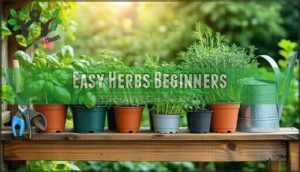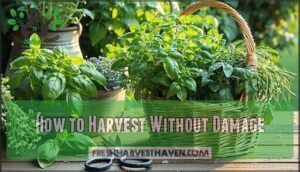This site is supported by our readers. We may earn a commission, at no cost to you, if you purchase through links.

These herbs thrive in containers on windowsills, balconies, or small garden plots with just basic sunlight and water. Choose fast-growing options that match your space and cooking preferences.
Basil loves warmth, chives tolerate neglect, and cilantro grows rapidly in cooler weather. Start with quality potting soil and containers with drainage holes.
Most herbs need 4-6 hours of sunlight daily and water when soil feels dry. The secret lies in selecting varieties that practically grow themselves, giving you fresh flavors within weeks while teaching essential gardening skills that expand your green thumb naturally.
Table Of Contents
- Key Takeaways
- Starting Herb Garden
- Easy Herbs Beginners
- Herb Garden Basics
- Top 7 Easy Herbs
- Growing Herbs Containers
- Herb Garden Maintenance
- Common Herb Problems
- Harvesting Herbs
- Expanding Herb Garden
- Frequently Asked Questions (FAQs)
- How do you start an herb garden for beginners?
- What are the easiest herbs to grow in the garden?
- Which herbs should not be planted together?
- What is the mother of all herbs?
- What are the best herbs for beginners?
- How do I start a herb garden?
- Can you grow herbs from a garden?
- Are herbs easy to grow?
- What herbs can you grow in your garden?
- What is a good herb garden for a beginner?
- Conclusion
Key Takeaways
- You’ll succeed with foolproof herbs like basil, chives, and cilantro that forgive mistakes and grow quickly, giving you confidence while learning essential gardening skills.
- Start with proper setup by choosing containers with drainage holes, quality potting soil, and a sunny spot with 6-8 hours of daily sunlight for optimal growth.
- Focus on easy maintenance through regular watering when the soil feels dry, pinching flower buds to encourage leaf growth, and harvesting in the early morning for peak flavor.
- Expand your garden naturally by adding companion plants that support each other’s growth and trying propagation methods like cuttings to multiply your favorite herbs for free.
Starting Herb Garden
Creating your first herb garden doesn’t require a green thumb or years of experience.
You’ll need to select beginner-friendly herbs that thrive in your climate and prepare a suitable growing space with proper drainage and sunlight, which includes having proper drainage.
Choosing Right Herbs
Choosing the right herbs sets you up for gardening success.
Start with foolproof varieties that thrive in your space and match your cooking habits. Consider flavor profiles and growth habits when selecting—aggressive spreaders like mint need containment, while compact herbs like thyme stay put.
- Beginner herbs like basil and chives forgive mistakes and bounce back quickly
- Culinary uses matter most—grow what you’ll actually cook with regularly
- Space constraints determine whether you need compact varieties or sprawling types
- Easy herbs reward new gardeners with fast growth and continuous harvests
Preparing Garden Space
Perfect herb garden prep starts with sunlight assessment—your herbs need six hours daily.
Pick spots with drainage solutions like containers with holes or raised beds.
Skip garden soil; use quality potting mix instead.
Herbs often thrive in soil with neutral to alkaline pH.
Garden layout matters for space optimization.
Here’s your planning guide:
| Factor | Container Option | In-Ground Option |
|---|---|---|
| Drainage | Add holes to pots | Create raised beds |
| Soil | Potting mix only | Amend with compost |
| Mobility | Move for sun | Fixed location |
| Soil testing | Not needed | Test pH first |
Smart beginner herb garden prep prevents headaches later!
Easy Herbs Beginners
You’ll find success with these beginner-friendly herbs that forgive mistakes and grow quickly in most conditions.
Start with basil, chives, cilantro, and dill since they’re nearly impossible to kill and provide fresh flavors for your kitchen within weeks, making them a great choice for beginners who want to see quick results.
Basil for Culinary Delights
Basil transforms your beginner herb garden into a culinary powerhouse with minimal effort required. This aromatic superstar thrives in sunny conditions and delivers impressive harvests that’ll make your neighbors jealous.
Looking at the paragraph about basil and the engaging, conversational tone throughout the content, here’s a short blockquote that captures the same energy:
Basil: the aromatic superstar that turns gardening rookies into harvest heroes overnight.
Basil Varieties range from classic sweet basil perfect for Pesto Perfection to exotic Thai basil adding authentic Asian flair. Your easy herb gardening journey becomes rewarding when you discover how different Culinary Pairings elevate everyday meals – sweet basil with tomatoes, purple basil in salads, or lemon basil in marinades.
A key to success is ensuring well-draining soil for maximum growth.
Fresh vs Dried basil offers distinct advantages, though fresh leaves provide superior flavor intensity. Smart Basil Preservation techniques extend your harvest season substantially.
- Sweet basil creates restaurant-quality pesto and marinara sauces at home
- Thai basil delivers authentic licorice notes for stir-fries and curries
- Lemon basil brightens dressings, cocktails, and seafood preparations perfectly
- Purple basil adds striking color contrast while providing spicy heat
Chives for Low Maintenance
Chives prove that you don’t need a green thumb for herb garden success.
These low maintenance herbs tolerate freezing temperatures and poor soil while producing edible flowers and flavorful leaves year-round.
Their natural pest resistance makes them perfect for beginners pursuing easy herb gardening.
| Feature | Benefit |
|---|---|
| Chive varieties | Choose from common, garlic, or giant types |
| Propagation methods | Divide clumps or grow from seed easily |
| Companion planting | Repels aphids from tomatoes and roses |
| Growth habit | Perennial that returns stronger each year |
| Harvest method | Cut like grass—they’ll keep growing back |
Cilantro for Fast Growth
Cilantro grows at lightning speed, delivering fresh leaves within weeks of planting.
You’ll want to sow seeds every 2-3 weeks for continuous harvests since cilantro bolting happens quickly in warm weather. Plant in partial shade during summer heat to extend leaf production.
Coriander spice develops when plants flower, offering dual culinary uses. Propagation methods include direct seeding since cilantro dislikes transplanting.
One should note that consistent soil moisture is essential for ideal growth. Fast growing herbs like cilantro make perfect herb garden choices for beginners seeking quick results.
Dill for Versatility
Versatility makes dill one of the best herbs to grow for herb garden beginners. This annual thrives in full sun with well-drained soil, offering multiple culinary uses from feathery leaves to flavorful seeds. Direct sow seeds since dill doesn’t transplant well.
- Culinary Uses: Fresh fronds enhance fish dishes, while seeds add punch to pickles and bread
- Companion Planting: Attracts beneficial insects and grows well near tomatoes and cucumbers
- Dill Preservation: Dry leaves and seeds easily for year-round seasoning
Growing herbs becomes rewarding when you discover dill’s medicinal benefits and cooking potential. Different dill varieties offer unique flavors—from common dill to fernleaf types perfect for containers. Your herb garden will flourish as this self-seeding annual returns each season, providing continuous harvests for your kitchen adventures.
Herb Garden Basics
Your herb garden’s success starts with understanding two fundamental requirements: sunlight exposure and soil conditions.
Most herbs need 6-8 hours of direct sunlight daily and well-draining soil that doesn’t stay waterlogged after rain or watering, which are crucial for their growth and well-draining soil conditions.
Sunlight and Watering Needs
Understanding light requirements and watering frequency sets your herbs up for success.
Most herbs need six hours of direct sunlight daily, though parsley tolerates partial shade.
Mediterranean herbs like rosemary prefer drier growing conditions, while basil wants consistently moist soil.
Check moisture by inserting your finger one inch deep—water when dry.
Watch for overwatering signs like yellowing leaves or underwatering signs like wilting.
Proper drainage solutions prevent root problems that kill herb gardens.
A successful garden needs adequate sunlight products and careful attention to these details to thrive with proper care.
Soil Selection and Preparation
Your herb garden’s success depends on proper soil selection and preparation. Start by testing your soil pH using simple test strips—herbs thrive in slightly acidic to neutral conditions between 6.0 and 7.0.
Drainage importance can’t be overstated since soggy roots kill herbs faster than drought. Mix organic amendments like compost into heavy clay soil types to improve structure.
For containers, use a quality organic potting mix rather than garden soil. Create welldraining soil by adding perlite or coarse sand to your herb garden soil.
These testing methods and soil improvements set the foundation for healthy herb growth. Adding aged compost can substantially improve soil structure.
Top 7 Easy Herbs
You’ll discover these seven reliable herbs that practically grow themselves, making them perfect for new gardeners who want guaranteed success.
Each variety offers unique flavors and requires minimal care, so you can focus on enjoying fresh herbs instead of worrying about complicated growing techniques, which is ideal for those seeking minimal care.
1. organic leafy greens lettuce seeds
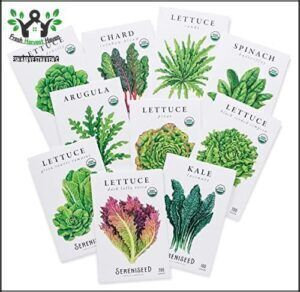
Starting your herb garden for beginners becomes simpler when you begin with familiar greens you already know.
Organic Seed Benefits shine through these certified organic leafy greens lettuce seeds, offering you 10 USDA-approved varieties including Green Towers Romaine and Black Seeded Simpson.
Each packet includes Germination Best Practices printed directly on the back, removing guesswork from your starting herb garden journey.
These Lettuce Seed Types are 100% non-GMO and open-pollinated, guaranteeing reliable sprouting rates.
You’ll find success Growing Leafy Greens in traditional gardens or hydroponic setups.
While some varieties need cooler conditions for germination, proper care rewards you with robust, flavorful lettuce throughout the season.
Consider Lettuce Companion Plants like chives and basil to enhance your organic herb garden productivity and natural pest control.
2. Pea Trellis Garden Support System

Maximize your herb garden’s potential with strategic Trellis Design that transforms vertical space into productive growing areas.
This spiral metal support system extends to 53.6 inches, offering Space Optimization for climbing Pea Varieties and vining herbs in your starting herb garden.
The innovative design features nine assembly brackets and anti-rust coating for durability across seasons.
Vertical Gardening reduces plant diseases by 40-70% through improved air circulation, making it perfect for herb garden beginners seeking healthier plants.
While some Trellis Materials could be sturdier, most gardeners find assembly straightforward and appreciate the compact folding feature for winter storage.
This system works exceptionally well for climbing herbs like peas, beans, and cucumbers in your herb garden.
The space-saving design allows you to grow more varieties without expanding your garden footprint.
Herb garden tips suggest positioning trellises on the north side to prevent shading shorter plants, maximizing your herb garden ideas potential.
3. Potato Grow Bags with Handles
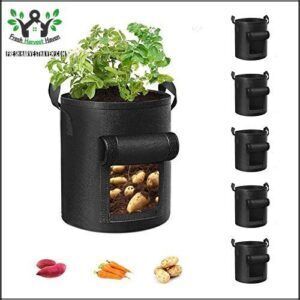
Potato grow bags revolutionize container herb garden setups by offering unmatched portability benefits and space efficiency. These breathable fabric containers solve common drainage needs while preventing root circling that plagues traditional pots.
Here’s what makes potato grow bags perfect for herb garden beginners:
- Bag Material: Heavy-duty fabric guarantees durability and proper airflow
- Size Selection: Choose 10-gallon capacity for ideal root development
- Drainage Needs: Fabric construction prevents waterlogging naturally
- Portability Benefits: Reinforced handles enable easy repositioning for sunlight
- Reusability Factors: Quality bags last multiple growing seasons
The visualization window lets you monitor growth without disturbing plants—perfect for container herb garden management. Simply fill with lightweight potting mix and plant herbs 4-6 inches deep. These bags deliver impressive yields while fitting seamlessly into herb garden ideas for small spaces. You’ll appreciate how they transform any patio into a productive growing area, making them ideal for herb garden tips focused on maximizing limited space.
4. Heirloom Rainbow Tomato Seed Mix

You’ll love adding colorful tomato varieties to your herb garden setup.
This heirloom benefits collection delivers stunning rainbow colors – red, orange, yellow, and green tomatoes in multiple shapes and sizes.
The non-GMO, open-pollinated seeds show excellent germination rates when you store them properly in cool, dry conditions.
Seed starting becomes simple with detailed growing instructions included in each packet.
Whether you’re using a mini greenhouse or grow lights, these guidelines help beginners succeed.
The indeterminate plants produce both large and small fruits perfect for fresh eating, cooking, or preserving.
This mix offers perfect garden integration alongside your herb garden plants.
While your herb garden kit provides seasonings, these tomatoes add fresh produce to complete your homegrown meals.
The open-pollinated nature means you can save seeds for next year’s garden.
Best For: Gardeners wanting vibrant heirloom tomatoes for fresh eating, cooking, or canning alongside their herb collection.
5. Heirloom Watermelon Radish Seeds Pack
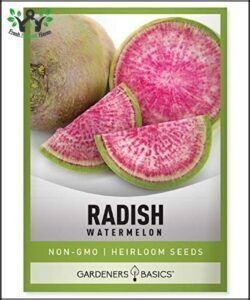
You’ll be amazed by watermelon radishes – these cold-tolerant gems bring stunning visual appeal to your herb garden.
Their green exterior hides a vibrant pink interior that’ll make your salads Instagram-worthy.
Radish Characteristics make them perfect for beginners.
These Heirloom Varieties mature in just 60 days, giving you quick satisfaction.
Planting Radishes couldn’t be simpler – sow seeds 1/2 inch deep, spacing them 1 inch apart in well-draining soil.
Radish Benefits extend beyond looks:
- Thrive in cool spring and fall weather
- Require consistent moisture but forgive occasional neglect
- Add mild, sweet flavor with peppery hints
- Perfect for herb garden care routines
- Complement other herb garden plants beautifully
For beginners building their herb garden kit, watermelon radishes offer foolproof success.
They prefer temperatures between 50-65°F, making them ideal companions to cool-season herbs.
Harvesting Radishes happens when they’re 2-3 inches across – don’t wait too long or they’ll become woody.
6. Indoor Pepper Growing Seed Variety

Anyone can successfully grow peppers indoors with the right approach.
Indoor pepper growing seed variety kits offer beginners an excellent introduction to indoor herb garden cultivation.
These packages typically include multiple pepper seed types from mild bells to spicy habaneros, plus essential supplies like soil disks and containers.
| Pepper Type | Heat Level (SHU) | Growing Time |
|---|---|---|
| Bell Peppers | 0-500 | 70-80 days |
| Jalapeños | 2,500-8,000 | 65-75 days |
| Habaneros | 100,000-350,000 | 90-100 days |
| Serranos | 10,000-25,000 | 75-85 days |
For ideal pepper plant care, maintain temperatures between 65-75°F using heat mats.
Provide adequate indoor pepper light through grow lights or sunny windows.
The pepper growing medium should drain well—upgrade from included coco coir to nutrient-rich potting mix after germination.
Common pepper problems include overwatering and insufficient light.
These easy-to-grow herbs reward consistent care with flavorful harvests perfect for indoor gardening enthusiasts.
7. cucamelon seeds for home garden

Cucamelon origins trace back to Mexico and Central America, where these "mouse melons" have grown wild for centuries.
You’ll find growing cucamelons surprisingly simple – they’re actually easytogrow herbs that belong in every herb garden for beginners guide.
These vigorous vines produce grape-sized fruits with cucamelon taste that blends cucumber coolness with lime tartness.
Start seeds indoors 4-6 weeks before last frost, then transplant after soil reaches 65°F.
Provide sturdy trellises for their 6-8 foot climbing habit.
Cucamelon benefits include high vitamin C content and natural probiotics when pickled.
Try fresh cucamelon recipes like salads, cocktail garnishes, or pickle them whole for tangy snacks.
Each plant yields 50-100 fruits throughout summer, making them perfect additions to your herb garden collection for beginners seeking unique flavors.
Growing Herbs Containers
Container gardening offers beginners complete control over soil quality, drainage, and plant spacing while allowing you to move herbs to ideal sun conditions throughout the day.
You’ll need containers at least 6-8 inches deep with drainage holes, using well-draining potting mix rather than garden soil to prevent root rot and guarantee healthy herb growth.
Benefits of Container Gardening
Container gardening transforms herb growing for beginners with Space Saving solutions that work anywhere.
Container gardening puts fresh herbs at your fingertips anywhere, anytime.
You’ll master Soil Control by choosing perfect growing mediums while avoiding contaminated garden dirt.
Portability Options let you chase sunlight or bring your indoor herb garden inside during harsh weather.
Pest Control becomes simpler since containers create barriers against ground-dwelling insects and slugs.
Reduced Weeding saves hours of maintenance time compared to traditional plots.
Container gardens offer flexibility that makes easy-to-grow herbs accessible to apartment dwellers and newcomers alike.
Your herb collection stays manageable and productive in these controlled environments.
Many gardeners find success using specialized gardening products.
Choosing Right Containers
Your herb garden containers need proper drainage holes to prevent waterlogged roots that kill plants. Size matters for healthy growth – small pots restrict root development while oversized containers waste space and soil.
Container Material affects your herbs’ success:
- Terra cotta pots provide excellent airflow but dry out quickly
- Plastic containers retain moisture longer and offer better portability options
- Ceramic planters combine aesthetic appeal with good drainage needs
Choose containers based on each herb’s mature size. Basil needs deeper pots than chives. Consider portability options if you’ll move containers seasonally. Many people find success using specialized garden containers. Match container style to your space for maximum aesthetic appeal in your beginner gardening journey.
Herb Garden Maintenance
Once you’ve planted your herb garden, proper maintenance keeps your plants healthy and productive throughout the growing season.
Regular watering, strategic pruning, and simple mulching techniques will guarantee your herbs thrive and provide fresh flavors for months to come, ensuring they remain healthy.
Watering and Mulching
Proper watering keeps your herbs thriving without drowning them. Check soil moisture by sticking your finger one inch deep—if it’s dry, it’s time to water.
Watering frequency varies by season: every 2-3 days in summer, less in winter. Watch for overwatering signs like yellowing leaves or musty smells.
Organic mulch like straw retains soil moisture and blocks weeds. For containers, small pebbles work as mulch types, improving drainage while reducing evaporation—your efficient irrigation strategy.
To prevent weeds, consider regular weeding practices to keep herbs healthy.
Pruning and Training Herbs
Smart pruning techniques turn your herb garden into a productive powerhouse.
Encouraging growth starts with these essential steps:
- Pinch flower buds when they appear – removing flowers redirects energy to leaf production
- Cut stems just above leaf pairs to promote branching
- Shaping herbs through regular trimming prevents overcrowding and improves airflow
- Select clean, sharp scissors for precise cuts that heal quickly
These gardening tips for beginners guarantee your herb harvesting stays bountiful all season long.
Common Herb Problems
Even experienced gardeners face herb problems, but most issues are easily fixable with the right approach.
You’ll encounter common challenges like aphids, fungal diseases, and yellowing leaves that signal nutrient deficiencies or watering mistakes, which can be considered common challenges.
Identifying Pests and Diseases
Your herbs might face unwelcome visitors, but spotting trouble early keeps your garden thriving. Regular herb troubleshooting prevents small problems from becoming disasters.
Common herb pests and herb diseases include:
- Aphids – tiny clusters on stems causing sticky residue
- Powdery mildew – white coating from overwatering or poor airflow
- Spider mites – fine webbing with stippled leaves
- Root rot – blackened roots from soggy soil conditions
- Leafminers – distinctive tunnel patterns through foliage
Check your plants weekly for disease symptoms. Organic control works best when you catch issues early.
Addressing Nutrient Deficiencies
Beyond spotting garden pests, identifying deficiencies through leaf changes reveals your herb garden’s hidden needs.
Yellow leaves signal nitrogen deficiency, while purple undersides indicate phosphorus problems.
Soil testing kits under $25 help beginners pinpoint issues before they escalate.
Quick organic amendments include compost tea for overall health, worm castings for micronutrients, or diluted fish emulsion for nitrogen-hungry herbs.
These fertilizer options address deficiency symptoms naturally without overwhelming delicate plants.
Most growing conditions improve dramatically with proper soil preparation and targeted fertilizer applications.
Harvesting Herbs
Knowing when and how to harvest your herbs makes the difference between a thriving garden and a disappointing one.
You’ll get the best flavor and encourage continued growth when you harvest at the right time using proper techniques that won’t damage your plants, which is crucial for a thriving garden and to encourage continued growth.
When to Harvest
An early-morning harvest is your golden window for peak flavor—dew’s gone but heat hasn’t dulled the essential oils.
Wait until those leafy culinary herbs hit 6–8 inches tall before snipping, and always harvest just before flowering for prime timing.
Regular harvesting at the right stages keeps plants bushy and helps guarantee a steady supply of fresh herbs.
Tool selection and quick storage methods help you lock in flavor from your herb garden.
How to Harvest Without Damage
Gentle hands make all the difference when harvesting your herb garden. Use clean, sharp harvesting tools like scissors or pruners instead of yanking leaves by hand.
Cut stems at a 45-degree angle just above a leaf node to encourage regrowth. Proper timing matters—harvest in the morning after dew dries but before afternoon heat.
Focus on leaf selection by choosing healthy, mature leaves first. Stem cutting techniques vary: pinch basil tips, trim parsley’s outer stems.
Good post-harvest care keeps your fresh herbs thriving through regular pruning and herb garden maintenance.
Expanding Herb Garden
Once you’ve mastered your first few herbs, you’ll naturally want to expand your garden with more varieties and create a sustainable growing system.
Smart expansion involves adding complementary perennial herbs and companion plants that work together to create a thriving, self-sustaining herb ecosystem.
Adding New Herbs
Once you’ve conquered the basics of herb gardening and built confidence with your starter plants, expanding your collection becomes an exciting next step.
Garden expansion through herb propagation, seed starting, or buying seedlings opens up endless culinary possibilities while building your gardening skills.
Consider these expansion strategies for your herb garden setup:
- Seed starting indoors during late winter gives you broader variety choices and cuts costs
- Buying seedlings from nurseries provides instant gratification with established root systems
- Herb propagation from cuttings lets you multiply favorites like mint and basil for free
- The acclimation process helps new plants adjust gradually to your garden’s specific conditions
Creating Perennial Garden
With perennial herbs forming the backbone of your herb garden, you’ll enjoy continuous harvests year after year.
Smart Perennial Selection starts with hardy varieties like thyme, rosemary, and sage that thrive in your climate zone.
Soil Amendments create the foundation—mix compost into well-draining soil before planting.
Garden Design matters: arrange taller herbs like fennel behind shorter ones like chives for ideal sunlight.
Winter Protection keeps tender perennials alive through cold months using mulch and row covers.
Propagation Methods like division help expand your collection affordably while maintaining proven varieties.
Incorporating Companion Plants
Through strategic companion planting, you’ll maximize your herb garden’s potential while creating natural pest defenses. Beneficial pairings transform ordinary gardens into productive ecosystems where plants support each other’s growth and health.
Smart herb combinations deliver impressive results:
- Pest control – Basil near tomatoes repels hornworms while chives deter aphids from neighboring vegetables
- Growth enhancement – Marjoram planted alongside basil improves flavor and increases leaf production substantially
- Space optimization – Thyme and sage thrive together, sharing similar water needs while maximizing limited garden areas
These herb pairings create flavor improvement naturally while reducing maintenance for beginners starting their herb garden journey. Rotating crops annually helps to maintain nutrient balance.
Frequently Asked Questions (FAQs)
How do you start an herb garden for beginners?
Choose a sunny location with well-draining soil, then start with beginner-friendly herbs like basil, parsley, and chives.
You’ll need containers or garden space, quality potting mix, and consistent watering for success.
What are the easiest herbs to grow in the garden?
You’ll have the best luck starting with basil, chives, parsley, mint, and thyme. These herbs forgive mistakes, adapt to various conditions, and grow quickly from seeds or transplants.
Which herbs should not be planted together?
Avoid pairing mint with most herbs since it spreads aggressively and can overtake garden beds. Don’t plant fennel near other herbs as it inhibits their growth through natural compounds.
What is the mother of all herbs?
You’ll often hear basil called the "mother of all herbs" because it’s incredibly versatile, easy to grow, and forms the foundation of countless dishes worldwide.
What are the best herbs for beginners?
Like seeds waiting for spring rain, beginner herbs need your patient hand to flourish.
Start with basil, parsley, chives, mint, and thyme—they’re forgiving friends that tolerate mistakes while rewarding you with abundant harvests.
How do I start a herb garden?
Choose a sunny spot with 6-8 hours of direct sunlight and well-draining soil. Start with beginner-friendly herbs like basil, parsley, and chives in containers or garden beds.
Can you grow herbs from a garden?
From seed to table — you can absolutely grow herbs in your outdoor garden.
Plant annuals like basil and cilantro alongside perennials such as rosemary and thyme in well-draining soil with 6-8 hours of daily sunlight for fresh flavors year-round.
Are herbs easy to grow?
Yes, herbs are remarkably easy to grow! Most varieties like basil, chives, and mint thrive with minimal care, requiring just sunlight, well-draining soil, and regular watering for success.
What herbs can you grow in your garden?
From ancient monastery gardens to modern kitchens, you can grow numerous herbs including basil, cilantro, parsley, chives, mint, oregano, thyme, rosemary, sage, dill, and lavender in your garden.
What is a good herb garden for a beginner?
Start with beginner-friendly herbs like basil, parsley, chives, mint, and thyme. They’re forgiving, grow quickly, and thrive in containers or garden beds with 6-8 hours of sunlight daily.
Conclusion
Surprisingly, you’ll discover that your easy herb garden for beginners practically maintains itself once established.
You’ve learned to select foolproof herbs, prepare proper growing conditions, and identify common problems before they damage your plants.
These nine herbs provide fresh flavors while building essential gardening skills through hands-on experience.
Your windowsill collection will expand naturally as confidence grows, transforming both your cooking and connection to homegrown ingredients with minimal effort required.
- https://www.udel.edu/academics/colleges/canr/cooperative-extension/environmental-stewardship/lawn-and-garden/
- https://www.herbsociety.org/file_download/inline/b30630e2-d0a9-4632-a7da-14af53a07a67
- https://www.nrpa.org/uploadedFiles/nrpa.org/Grants_and_Partners/Environmental_Conservation/Community-Garden-Handbook.pdf
- https://lacabanefieutee.com/wp-content/uploads/2020/11/how-to-grow-more-vegetables-eighth-edition-and-fruits-nuts-berries-grains-and-other-crops.pdf
- https://mutualaiddisasterrelief.org/wp-content/uploads/2021/04/GaiasGarden-A-Guide-to-Home-Scale-Permaculture.pdf

